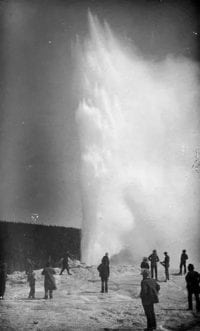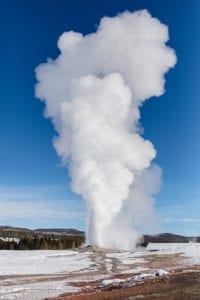Old Faithful
One of the main, if not THE main attraction in Yellowstone National Park is the Old Faithful geyser.

Discover the captivating tale behind one of Yellowstone National Park’s most renowned natural wonders, Old Faithful. In 1870, the intrepid Washburn Expedition journeyed down the picturesque Firehole River and stumbled upon the Upper Geyser Basin. Mesmerized by the rhythmic and dependable eruptions of a particular geyser, they christened it with the moniker “Old Faithful.” From that day forward, the moniker has stuck and Old Faithful has become a beloved icon of the park, drawing visitors from all over the world to witness its awe-inspiring eruptions.
The Science Behind Old Faithful’s Eruption

It is only under specific conditions that geysers like Old Faithful are formed. This makes them relatively rare. Pockets of underground water are superheated by the magma under the surface of the earth. Pressure builds up and this eventually causes the water to seek an escape route.
A tunnel through which the water escapes has a content of volcanic rock which has a high silica content and this is what lines the escape tunnel. Because of the rhyolite lining the tunnel can withstand the incredible heat and pressure that occurs during an eruption.
Old Faithful was the first geyser named in Yellowstone. It erupts currently about every 91 minutes on average. There is an app that you can download which will give you the approximate time of the next eruption.
The water that erupts from the geyser has been measured at 204 degrees Fahrenheit but the temperature of the escaping steam can be hotter than 305 degrees Fahrenheit.
It has been said that in the early days of Yellowstone, people would sometimes use the geysers to do their laundry. Supposedly they would throw their clothes into the geyser between eruptions and then wait patiently for their laundry to be shot back out of the geyser. Reportedly the clothes came out very clean but wool items did not fare too well at those temperatures.

The interval between eruptions appears to be getting longer. In the 1960’s there was a 66 minute average wait time between eruptions. Today that has changed to approximately 91 minutes.
We can only speculate about the reasons for this change. It may be due to earthquake activity in the area which can affect the water system structure below ground. The water tables may have changed over time or perhaps human activity is the reason. No one knows for sure.
There may well come a time in the future when Old Faithful will be no more than a memory and a history lesson. Come and see her while there is still time.
AUTHOR: SUE KNAPP